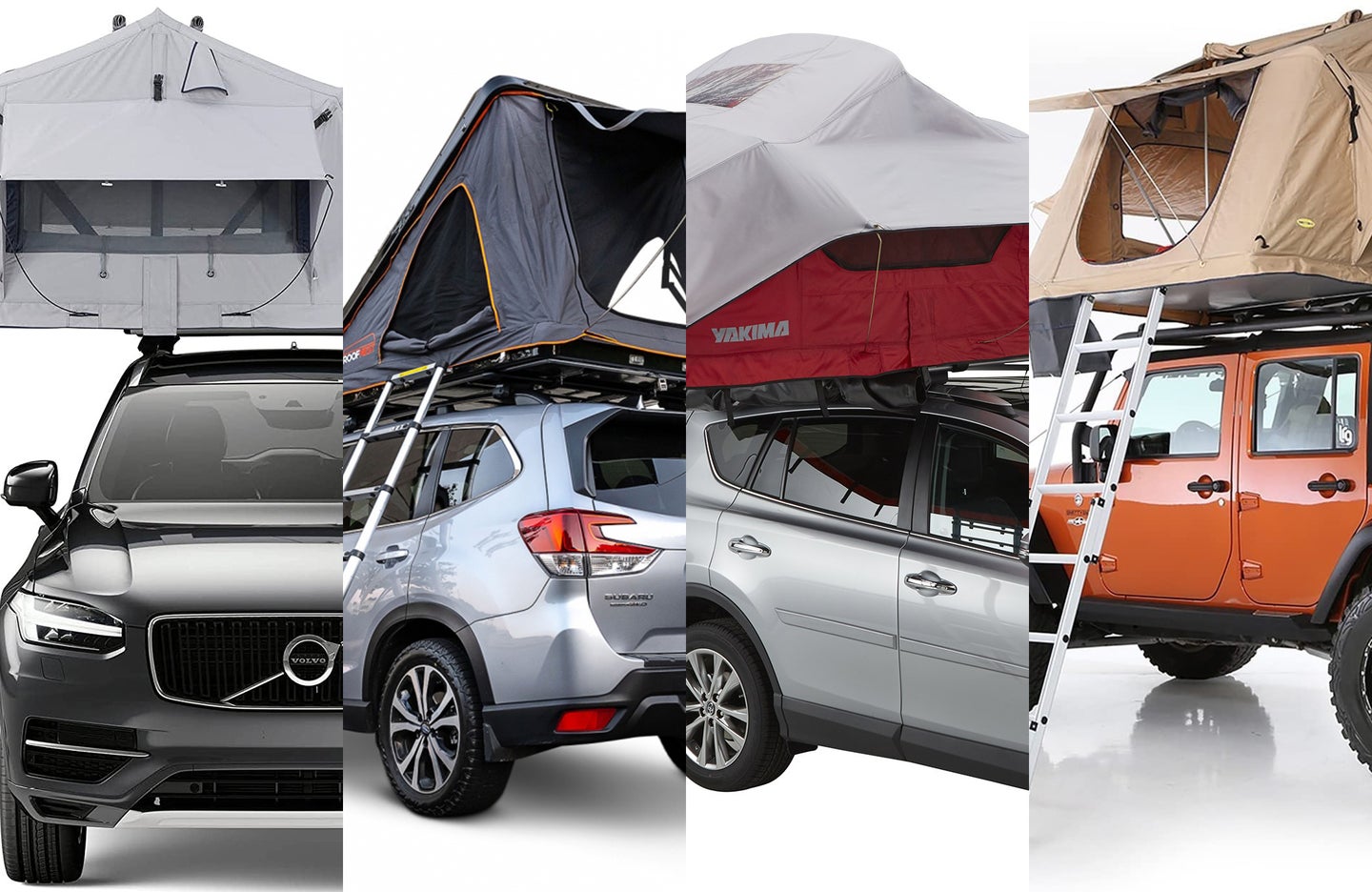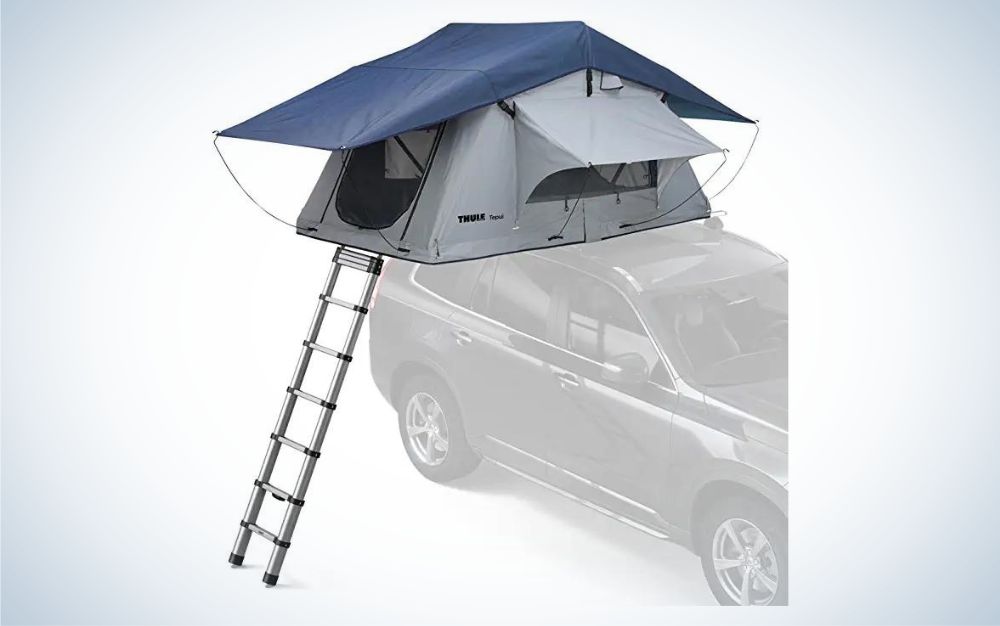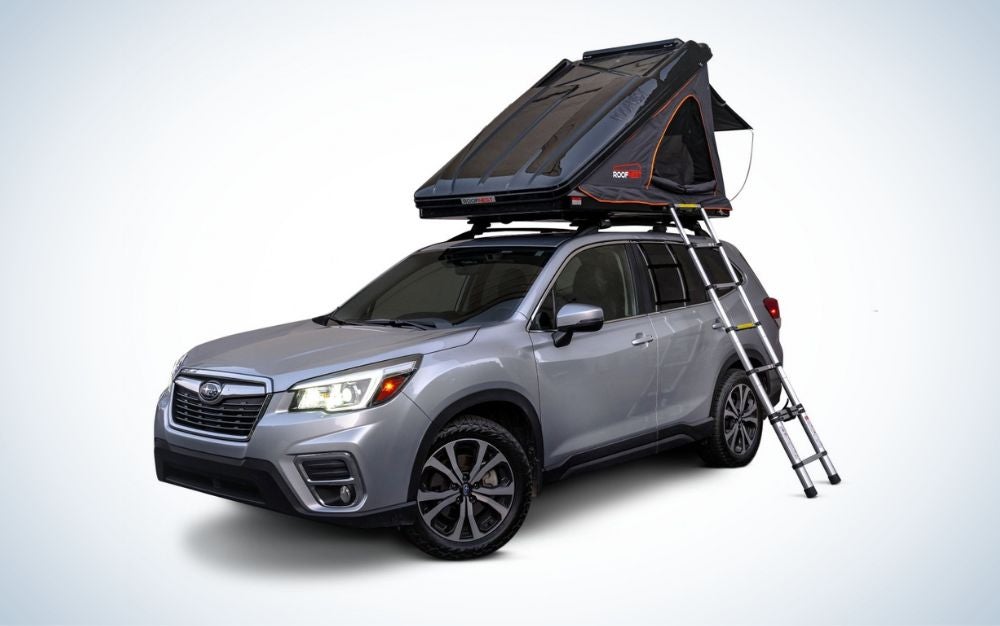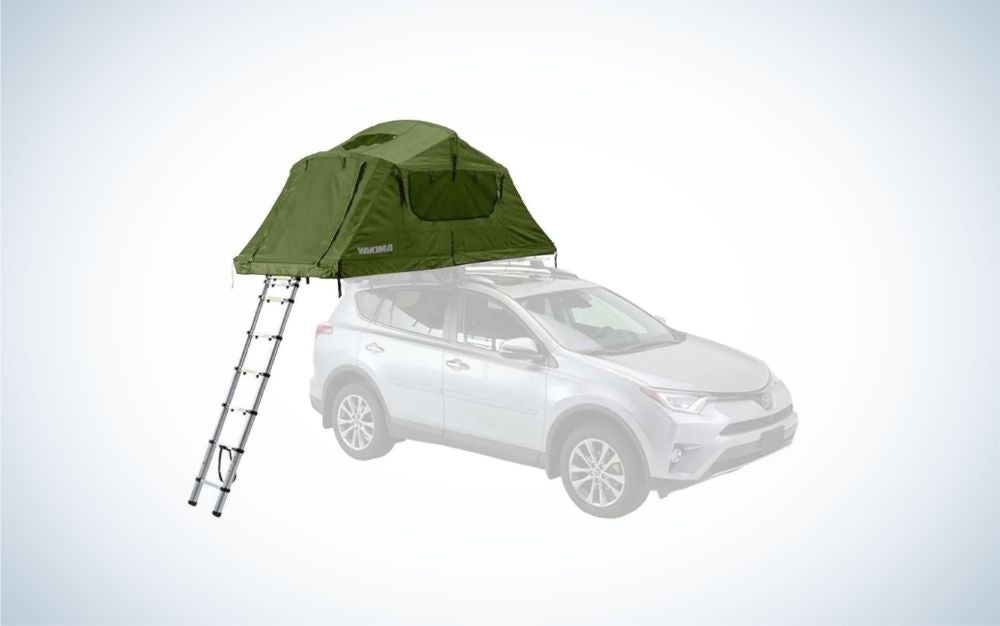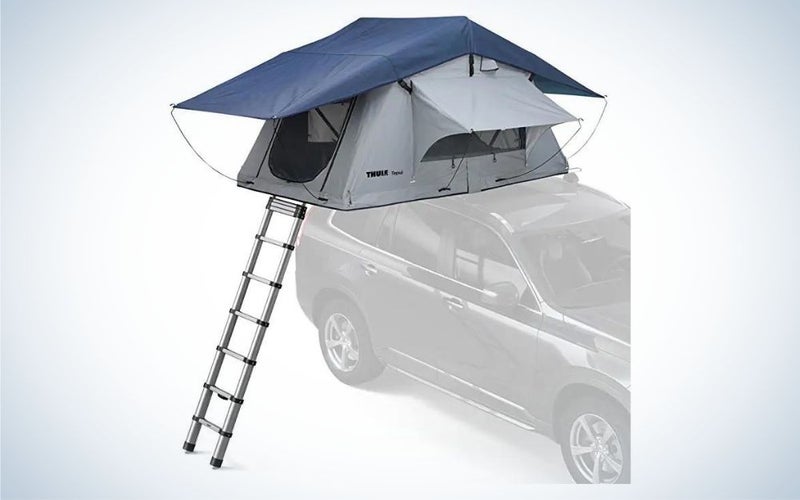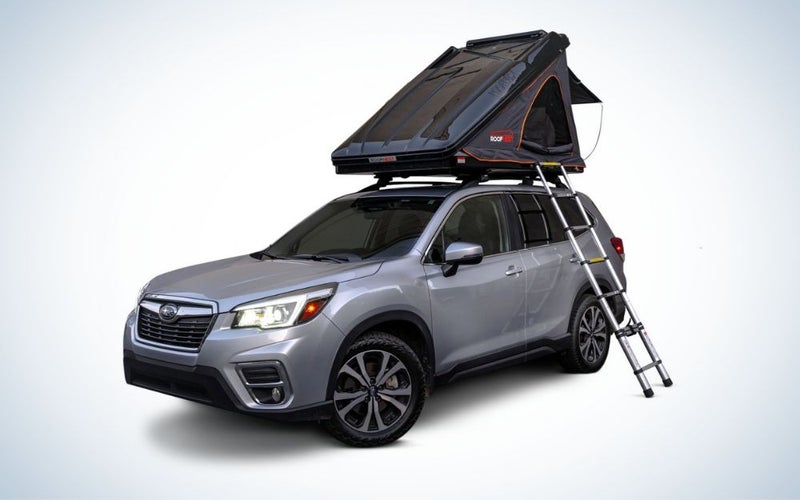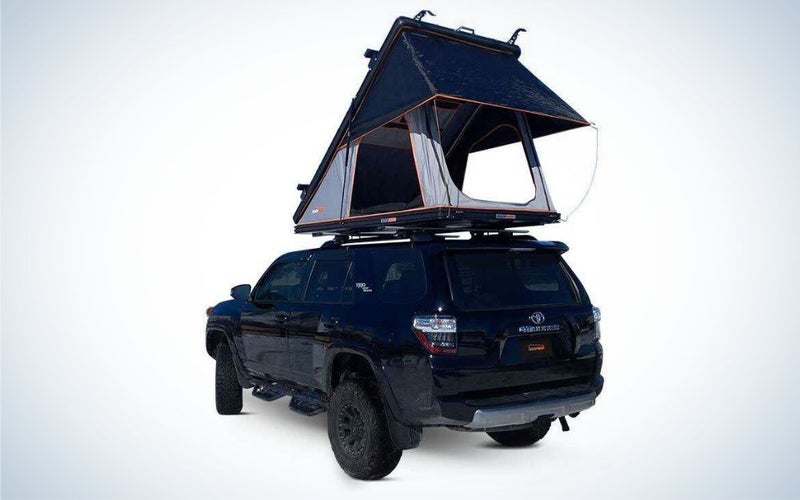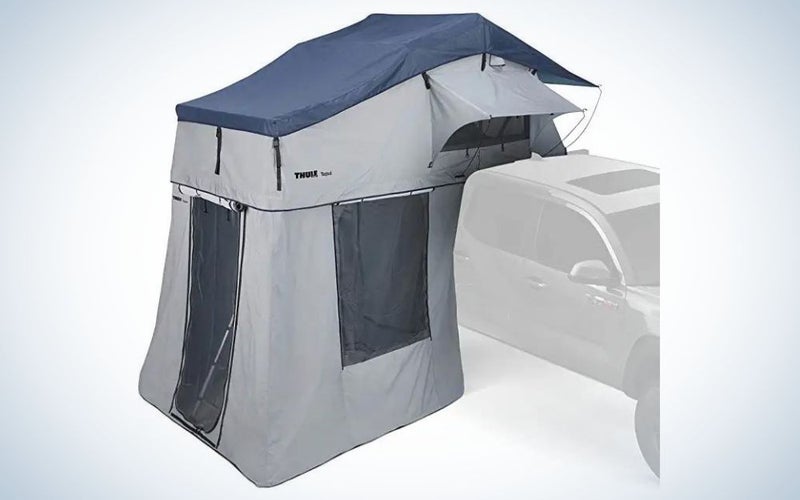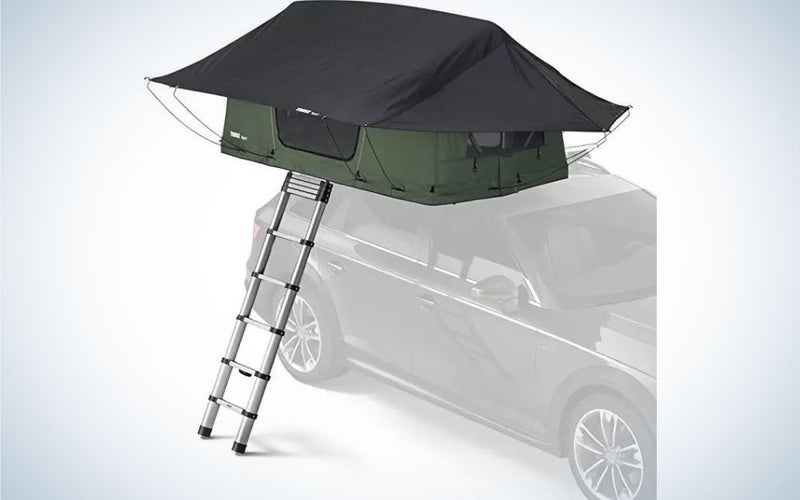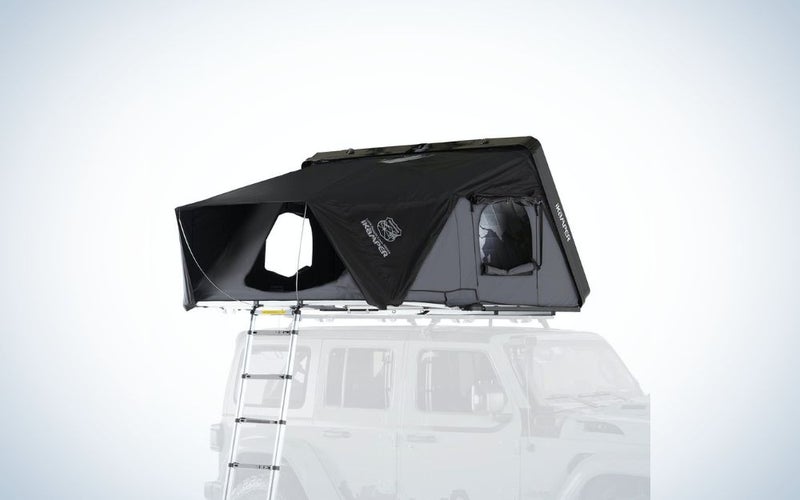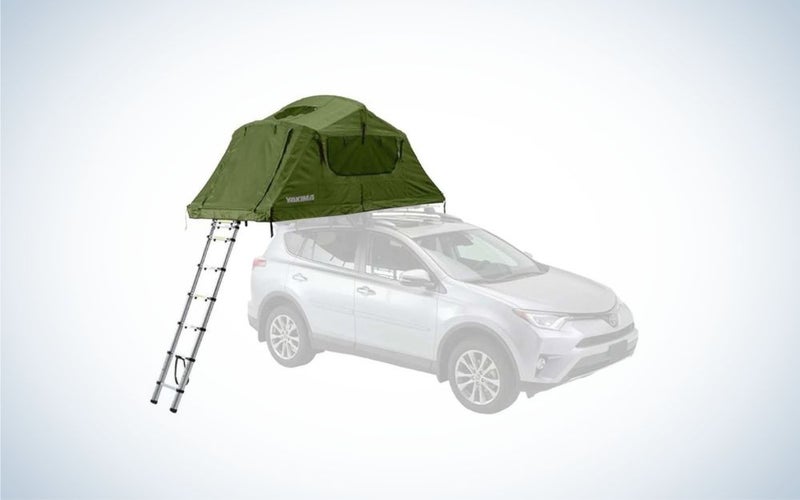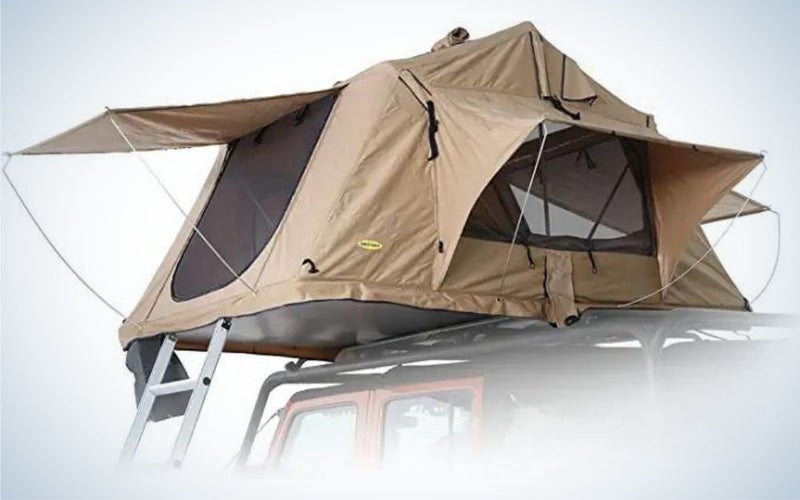We may earn revenue from the products available on this page and participate in affiliate programs. Learn more ›
Sometimes sleeping in a rooftop tent on your car is the most comfortable way to get a good night’s sleep. On an especially steamy evening during a months-long cycling trip in the Uzbekistan desert, some of my traveling companions opted for sleeping atop their Sprinter van in lieu of trying to find a suitable place to pitch a tent near a sketchy land border crossing. They insisted it was the best night’s sleep they’d had in weeks. Rooftop tents, sometimes called “RTTs,” can make sleeping on top of your car or truck more appealing and comfortable than resting inside your car or pitching a tent nearby. They fold out from the roof, sometimes extending past it, and come equipped with mattresses built into the floor. No more trying to sleep on a narrow camp cot or noisy inflatable mat. If you’re going camping with a car or truck, don’t sleep on grabbing one of the best rooftop tents.
- Best overall: Thule Tepui Kukenam 3
- Best hard shell: Roofnest Sparrow Eye
- Best environmental: Roofnest Falcon 2
- Best for Tacoma: Thule Tepui Autana 3
- Best for 4Runner: Thule Tepui Foothill
- Best for Jeep: iKamper Skycamp 3.0
- Best for overland: Yakima Skyrise Medium
- Best budget: Smittybuilt Overlander
How we picked the best rooftop tents
I’ve tested and written about a variety of outdoor-related gear for many publications, including HuffPost, Hearst, Adventure Cycling Magazine, BBC Travel, Fodor’s, and many others. As a person who finds solace and inspiration in nature, I’ve camped in environments ranging from state parks with reserved spots to roadsides in Armenia and Georgia (the country) to rocky cliffs in Pakistan to the open plains of Mongolia.
As a New Yorker whose primary mode of transportation is a bicycle, I do not drive. I do, however, have plenty of friends who have happily brought me along on camping adventures and weekend mountain biking trips, so long as I helped install and set up their rooftop tents. Over the years, I’ve used more than my fair share of rooftop tents and tried them on a wide array of vehicles.
The best rooftop tents: Reviews & Recommendations
Rooftop tents offer an innovative design that minimizes setup and maximizes comfort. When you pick one of the best, you’ll get a comfortable, cozy place to spend the night and stargaze. We’ve put together a lineup of rooftop tents that should fit any camper’s needs, including hard shells, soft shells, and options that specifically cater to a few popular SUVs.
Best overall: Thule Tepui Kukenam 3
Thule
Buy it used or refurbished: eBay
Why it made the cut: The Thule Tepui Kukenam 3 is a versatile, well-made tent that fits on most cars and racks for a reasonable price.
Specs
- Design: Fold out
- Capacity: 3 people
- Seasons: 4
- Floor area: 96 x 56 inches
- Peak height: 52 inches
- Windows: 3 side, 2 roof
- Tent material: 600D ripstop nylon
- Floor material: Aluminum w/insulated fiberglass sheet
- Pole material: Aluminum/spring steel
- Weight: 130 lbs
- Packed size: 48 x 56 x 12 inches
Pros
- Versatile
- Easy to set up
Cons
- No entrance awning
The Thule Tepui Kukenam 3 is an excellent rooftop, no matter what you’re driving or where you’re going. Its spacious interior comfortably fits two adults, or even three if you leave your gear outside. It’s very quick and easy to set up, especially for a soft-shell tent. You simply unfold the hinged platform and the tent emerges almost fully formed, so you can be ready for bed in less than 10 minutes.
It’s also incredibly tough, with 600D ripstop walls with taped seams and a 420D rainfly. Plus, it’s UV and mold-resistant. I’ve spent quite a few nights (and days) in a Kukenam waiting out torrential storms—the kind of storms that make you question why you wanted to sleep “out in the wilderness” to begin with—and have never experienced any damage or leakage. If you’re looking for something more breathable, it’s one of a handful of Thule Tepui tents that allows you to purchase alternate canopies at lighter weights for summer trips. No matter what’s going on outside, you’ll be cozy inside the Kukenam 3.
Best hard shell: Roofnest Sparrow Eye
roofnest
Why it made the cut: The Roofnest Sparrow Eye is perfect for anyone who likes to make a quick exit after a comfortable, good night’s sleep.
Specs
- Design: Clamshell
- Capacity: 2 people
- Seasons: 4
- Floor area: 83 x 49 inches
- Peak height: 44 inches
- Windows: 2 side
- Tent material: Polyurethane-coated polyester and cotton blend
- Floor material: Fiberglass reinforced ASA/ABS
- Pole material: Aluminum/spring steel
- Weight: 130 lbs
- Packed size: 50 x 88 x 6 inches
Pros
- Comfortable
- Quick set up and take down
- Easy to install on car
Cons
- Expensive
- Still large when packed
Roofnest’s Sparrow tents were among the first hard-shell rooftop tents on the market, and they’re still some of the best. Made with exceptionally durable materials, the two-person Sparrow Eye’s waterproof rating is three times more than most other tents, and features a high-density foam mattress, which ensures you’ll get an exceptional night’s rest even in stormy weather.
When set up, the tent has a triangle shape with the high end reaching a 44-inch peak height. The interior is plenty spacious for two people, with the low end still providing ample space to avoid any knee-knocking. The memory foam mattress provides ample cushioning so you won’t wake with sore shoulders from pressing into the metal platform underneath. There’s also tons of storage inside with a cargo net and two side pockets.
The Sparrow Eye is incredibly easy to set up and take down quickly. I’m one of those people who believe that having the ability to launch a hasty exit is essential (not that I necessarily engage in nefarious activities, I’ve just never been a fan of the long goodbye). You can get the whole up or down in just two minutes. The initial installation is also very easy: The tent arrives pre-assembled and ready to install on your vehicle straight out of the box.
Best environmental: Roofnest Falcon 2
roofnest
Why it made the cut: At less than half the thickness of almost every other rooftop tent, the Roofnest Falcon 2 is an aerodynamic, streamlined option that minimizes drag.
Specs
- Design: Clamshell
- Capacity: 2 people
- Seasons: 3
- Floor area: 86 x 48 inches
- Peak height: 60 inches
- Windows: 2 side
- Tent material: 320g poly-cotton
- Floor material: Honeycomb aluminum
- Pole material: Aluminum/spring steel
- Weight: 160 lbs
- Packed size: 88 x 50 x 6.5 inches
Pros
- Comfortable
- Easy setup
- Aerodynamic size
Cons
- Expensive
If you’re concerned about your tent slowing down and making your car less fuel-efficient, Roofnest also makes the Falcon 2, a tent designed with aerodynamics in mind. It opens up to a full 60 inches on the high side of its sloped roof, which is as tall as we’ve ever encountered. When collapsed, it packs down flat to minimize the impact of the tent on your ride.
While the interior space is cozier than many of our other picks, the mattress is very comfortable for sleeping and gazing at the stars. The tent canopy, made from a polyester cotton blend, is more breathable than the ripstop found in many rooftop tents, though not quite as durable. It also offers a bunch of useful bells and whistles, including storage pockets, a cargo net, boot bags, and USB-powered LED lights.
One thing to keep in mind: The thin packed size doesn’t allow you to store much else inside when in travel mode, though, including the ladder, so make sure you save some extra space in your car.
Best for Tacoma: Thule Tepui Autana 3
Thule
Buy it used or refurbished: eBay
Why it made the cut: With an annex that drops down to ground level, this truck rooftop tent works well on the cab of a Tacoma (or a cab height bed rack).
Specs
- Design: Fold out
- Capacity: 3 people
- Seasons: 4
- Floor area: 56 x 96 inches
- Peak height: 52 inches
- Windows: 3 side, 2 roof
- tent material: 420D ripstop nylon
- Floor material: Aluminum
- Pole material: Aluminum/spring steel
- Weight: 130 lbs
- Packed size: 48 x 56 x 12 inches
Pros
- Includes an annex
- Comfortable
- Excellent weather protection
Cons
- Long conversion time
- Expensive
With a comfortable foam mattress, roomy interior, and two large sky windows, the Thule Tepui Autana 3 is one of the best bedroom hangouts you’ll get out of a soft-shell tent. The entrance awning protects the ladder from stormy weather and gives you some privacy from neighboring campers. If you open the two huge sky windows and remove the rain flap, you’ll sleep among the stars from inside your tent.
The Autana 3 comes with an annex, which hangs off the side of the car from the tent floor, creating a whole other room to change, store gear, or relax. It has two doors so you can access the back of your vehicle from inside the annex, as well as windows on the remaining two sides. It doesn’t store inside the tent when packed up, though, so save some room for it.
Best for 4runner: Thule Tepui Foothill
Thule
Buy it used or refurbished: eBay
Why it made the cut: The low-profile Thule Tepui Foothill folds down in a long, narrow style, leaving room on your 4runner’s roof rack for other gear.
Specs
- Design: Fold out
- Capacity: 2 people
- Seasons: 3
- Floor area: 84 x 47 inches
- Peak height: 38 inches
- Windows: 3 side, 2 roof
- Tent material: 600D ripstop nylon
- Floor material: welded aluminum
- Pole material: aluminum/spring steel
- Weight: 122 lbs
- Packed size: 84 x 24 x 9.5 inches
Pros
- Quick installation
- Compact
- Durable
Cons
- Takes a long time to set up
- Flimsy mattress
The low-profile Thule Tepui Foothill is designed to break down into a smaller, more rectangular shape. In its compact form, it leaves plenty of room on your roof rack for other roof-rack-ready gear like a kayak.
The A-frame-shaped Foothill provides amazing views with the roof panels open. They open lengthwise, so there’s only a single center support to potentially block your view. By opening the door and three walls, you can create a wonderful panoramic view to take in the scene as you settle in for the evening.
Because of its slim travel size, the Foothill takes more time than other tents to convert into sleeping mode. That isn’t ideal, but a little extra setup time is a small price to pay for the size and capacity for killer views.
Best for Jeep: iKamper Skycamp 3.0
ikamper
Buy it used or refurbished: eBay
Why it made the cut: A spacious, premium tent with tons of features that is the perfect companion for your all-season, all-weather jeep adventures.
Specs
- Design: Clamshell
- Capacity: 4 people
- Seasons: 4
- Floor area: 83 x 77 inches
- Peak height: 48 inches
- Windows: 3 side, 1 roof
- Tent material: Black-out 300 gsm poly-cotton canvas
- Floor material: Honeycomb aluminum
- Pole material: aluminum/spring steel
- Weight: 165 lbs
- Packed size: 85.5 x 55 x 13 inches
Pros
- Extremely durable
- Comfortable mattress
- Easy to convert
Cons
- Heavy
- Expensive
An expandable, hard-shell rooftop tent that sets up in 60 seconds, the Skycamp 3.0 offers ample sleeping space inside for three adults (or two adults and two children) on a very plush 2.5-inch insulated polyfoam mattress. It’s definitely one of the most comfortable mattresses we’ve tried in a rooftop tent. It almost feels like something you’d find in a hotel.
At the same time, the Skycamp 3.0 was built with a durable, double-layered shell, thick poly-cotton canvas, and waterproof zippers on the doors and windows to withstand the elements, including snow and hail. With a jeep and your Skycamp, you can weather almost any kind of storm.
Best for overland: Yakima Skyrise Medium
BackCountry
Buy it used or refurbished: eBay
Why it made the cut: The Yakima Skyrise Medium is a comfortable, reasonably priced tent that’s incredibly easy to put on and take off your vehicle.
Specs
- Design: Fold out
- Capacity: 3 people
- Seasons: 3
- Floor area: 96 x 56 inches
- Peak height: 48 inches
- Windows: 3 side, 2 roof
- Tent material: 210D nylon
- Floor material: Aluminum
- Pole material: Aluminum/spring steel
- Weight: 115 lbs
- Packed size: 58 x 48 x 16 inches
Pros
- Tool-free mounting
- Medium price range
- On the light side
Cons
- Mounting system limits width
If you think you’ll need to install and remove your tent from the roof of your car, you should consider the Yakima Skyrise. It features a tool-free, quick-release mounting system, making that process very quick and easy. You can also position the Skyrise to fold out the back of your vehicle as opposed to the side if you’d rather, something no other tents we’ve found allow for without additional drilling and labor.
At 48 inches, the Skyrise is on the short side as far as rooftop tents go, but I still found the interior adequately spacious. The awning is completely removable, so you can detach the rainfly and open the windows to achieve an almost completely open-air experience, comparable to sleeping on the top of a Sprinter van in the Uzbekistan desert near a sketchy land border crossing.
That being said, it isn’t made from the most durable stock. Its 210D nylon is much thinner than most of our picks. The workmanship is stellar, but it’s just not made with materials as rugged as some other options.
Best budget: Smittybilt Overlander
Smittybilt
Buy it used or refurbished: eBay
Why it made the cut: The Smittybilt Overlander offers many of the same features as high-end rooftop tents for less than half the price.
Specs
- Design: Fold out
- Capacity: 2 people
- Seasons: 3
- Floor area: 56 x 96 inches
- Peak height: 51 inches
- Windows: 3 side, 2 roof
- Main tent materials: 600D ripstop nylon
- Floor material: Aluminum
- Pole material: Aluminum/spring steel
- Weight: 144 lbs
- Packed size: 48 x 56 x 12 inches
Pros
- Affordable
- Durable and sturdy
- Annex available for added capacity
Cons
- Heavy
- Velcro cover is awkward to take on and off
Smittybilt, as a company, has a reputation for manufacturing durable, sturdy, no-nonsense products, and the Overlander tent makes it clear why. The polyurethane canopy made from 600D nylon stands up well to all kinds of weather including torrential downpours and the ladder, at 17 inches, is one of the widest in rooftop tents.
Installing the Overlander on your vehicle is a more labor-intensive process than our other picks. It doesn’t come with all the tools you’d want for the installation—a ratchet set would be nice—and the ladder doesn’t offer enough adjustable height options, which has led many users to drill new holes to fit their cars. That said, once you have things set up, it’s straightforward to set up and take down.
Despite this, the Overlander is an exceptional value. It’s one of only a handful of options that costs less than $1,500, so it’s worth considering based on price alone.
What to consider when buying the best rooftop tents
Picking a rooftop tent isn’t all that different from picking a standard camping tent, but there are a few extra things to think about and they are extremely important. Since you’re setting it up on a car and sleeping many feet off the ground, it’s important that you take extra care and make sure you’re buying something that’s made for your car or truck and will support the weight of everyone and everything that goes inside it.
Once you’ve narrowed things down, the best rooftop tents will, like other kinds of tents, provide privacy protection from the elements and things that go bump or buzz in the night. They’ll also be easy to assemble, so you can spend more time enjoying the other aspects of camping, like slumbering under a star filled sky. Let’s walk through the process of picking a rooftop tent.
Make sure it’s a good fit
Rooftop tents are not one-size-fits-all, so you need to make sure that you’re buying one that will pair with your car.
Rooftop tents connect to your car via a roof rack. If you don’t have one installed, the tent won’t be able to attach, so that’s a dealbreaker. Roof racks range in complexity from simple cross bars mounted on the factory-installed roof rails to permanently installed heavy-duty platforms or baskets. Third-party roof racks are generally a better option for carrying a tent, as they can generally handle more weight than their manufacturer-installed counterparts.
If your car’s properly equipped, you’ll need to know the distance between the rack’s crossbars and the dimensions of your car’s roof. Each tent requires a certain minimum distance between the bars to fit on your roof, so compare the two numbers to see if the tent will fit. Likewise, the closed tent should fit on the roof so it doesn’t extend out past the front of your car or off the sides while you’re driving.
You’ll also want to check your roof rack’s “dynamic weight capacity,” which tells you how much weight it can support. Most tents weigh more than 100 pounds and most roof racks are made to handle up to 160 pounds, so the tent may push your rack’s limits.
Some tents also have additional requirements, so make sure to read the product description for the tent thoroughly before committing.
Space and static weight
Most companies describe tent size based on how many people can lie down and “sleep comfortably” at the same time. “Comfortably” in tent sizing is a relative term, though. If you are traveling with a platonic companion, you may find a 3-person rooftop tent more comfortable than a 2-person one. You should also look at the tent’s “static weight” capacity, which tells you how much weight the tent can support when set up in camping mode.
Ultimately, we recommend going with the smallest size that feels comfortable for you. Just keep in mind that the bigger the tent, the heavier and more cumbersome it will be.
Installation and setup
When using a rooftop tent, there are two types of setup. Before your trip, you’ll need to install the tent on your car or truck’s roof rack so it’s ready to use when you need it. In most cases, you’ll leave the tent on top of your vehicle for the duration of your trip. When you need to make camp, you’ll need to pitch or “convert” your tent from its flattened travel mode into a usable shelter.
Installing a rooftop tent on your car is almost always a two-person job as even the lightest options weigh over 100 pounds. Many tents will also feature additional assembly when using them for the first time.
The length of time it takes to convert your tent can vary quite a bit, but they all take much less time to set up than your average tent. Depending on the design, you may need to bend a frame into place, but many take just a few minutes to set up and take down.
Hard shell or soft shell?
There are two general types of rooftop tents: hard shell or soft shell, which vary based on the materials used to make the tent and how they are constructed.
Soft-shell tents are constructed with a hefty waterproof soft cover attached to the floor platform, and fold out beyond the edges of your vehicle’s roof. Poles and hinges hold it in place when in camping mode. Soft-shell tents usually have removable covers that protect the tent while in travel mode. These covers usually attach via velcro or straps and buckles. Some soft-shell covers can be cumbersome and awkward to stow between uses.
Hard-shell tents feature a fiberglass, plastic, or aluminum shell that opens and closes, clamshell style. This shell also doubles as the cover when the tent is in travel mode. The tent canopy folds down inside when closed. Most hard-shell tents do not have a larger footprint than the roof they sit upon which doesn’t affect their compatibility—it just means that hard shell tents, in general, have a smaller inner area than soft-shell ones.
While soft shells cost and weigh less than hard shells, they are normally not quite as durable nor sturdy. They also tend to be less aerodynamic and take longer to set up than a hard-shell version. When deciding which to buy, consider what features are most important to you. If you want to spend less and carry lower weight, go with a soft shell. If you want a tent that sets up quickly (in some cases in less than a minute) while also helping to keep your gas mileage down, a hard shell may be the right fit for you.
Tent durability and warmth
Tent canopies, the fabric walls of the tent, are often constructed with ripstop nylon ranging in thickness from 400-600 denier (D), which indicates a fabric’s weight and durability. The higher the number, the heavier the material is. Both of the Roofnest tents on our list feature polyurethane-coated polyester and cotton blend fabric attached to a hard shell tent design. The polyurethane makes the material especially durable and water-repellent.
Like all outdoor gear, RTTs are rated for a specific number of seasons (spring, summer, autumn, winter). Four-season tents feature heftier materials that will keep you warmer and can withstand being pelted with sleet or hail.
Mattress comfort
Many rooftop tents feature an integrated mattress, so the whole tent is your bed. The thickness—and, by extension, comfort—of these mattresses varies quite a bit, though. Less expensive tents like the Smitty Overlander, our budget pick, have a pretty thin and stiff mattress, while more expensive tents often stuff in more padding. Some companies, like Thule, offer a thicker sleeping pad as an optional upgrade.
Most tent mattresses come with a removable cover and an anti-moisture mat that goes underneath, so make sure the materials for the mattress are waterproof and breathable.
What about an automatic tent?
Some hard-shell options automatically pop up into shape with a push or nudge—sort of like an automatic sliding door on a car that closes after a soft push. As you might suspect, automatic opening tents cost more—they also have moving parts that could break, likely reducing their lifespan.
FAQs
Q: Can you put a rooftop tent on any car?
Yes and no. Any car with a well-made roof rack should be able to handle a rooftop tent. That said, different tents have different size and weight requirements, so tents and cars are not universally interchangeable. If you aren’t using an SUV or a truck, you probably also want to measure the roof of your car to make sure that the packed tent doesn’t extend past the front of the car or hang off the sides.
Q: Why are rooftop tents so expensive?
Rooftop tents are far more complex than your average tent. Unlike standard camping tents, rooftop tents have a rigid floor and a built-in mattress to make sleep on your car comfortable. They also usually include sturdier walls and sky windows for what many consider a more comfortable experience. Effectively rooftop tents function more like a portable room than a traditional tent, and those extra features make the tents more expensive.
If you’re currently not able to justify the expense of a rooftop tent, check out the best camping tents (linked in our “What to consider” section) for our thoughts on conventional models.
Q: Do roof racks and rooftop tents affect gas mileage?
Yes, the wind drag and extra weight of a rooftop tent will impact your car’s gas mileage. To minimize the effects of the tent on your car’s efficiency, consider its weight and the height of the tent in its packed form.
Final thoughts on the best rooftop tents
If you’re camping with your vehicle, the best rooftop tents are a wonderful way to spend the night in the great outdoors. One pretty much eliminates the need to search for an ideal, flat, section of ground to pitch a tent, and cuts down significantly on tent setup time. The integrated mattress also pretty much guarantees that you’ll be more comfortable than sleeping on the ground. It’s expensive, for sure, but a worthy investment for the right kind of camper.
